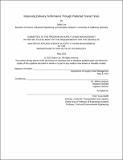Improving Delivery Performance Through Predicted Transit Times
Author(s)
Lee, Debra
DownloadSCM27_Lee_project.pdf (779.2Kb)
Terms of use
Metadata
Show full item recordAbstract
Maintaining high on-time delivery performance is critical for third-party logistics providers. Not only does reliable on-time delivery function as a competitive edge and allow logistics providers to serve their customers more effectively, but it can also improve operational efficiency for the provider itself. Our sponsor company is a third-party logistics provider that must balance a growing portfolio of shipments that leverage external less-than-truckload (LTL) carriers. We therefore proposed and validated a two-pronged approach that utilized machine learning to improve LTL transit time predictions and then used these predictions in an integer programming model to maximize on-time orders. Independently, the prediction model improved the transit time RMSE from 3.07 days to 1.97 days. However, we obtained the most improvement in delivery performance through the optimization problem. By investigating the effect of lengthening the buffer days, or additional days added to the lead time beyond the predicted transit time over a rolling weekly basis, we obtained up to a 41% improvement in on-time deliveries over the status quo. Overall, the research demonstrates the strength of this mixed approach and provides flexibility to expand to other modes of transportation or a variety of objectives that may arise when planning shipments.
Date issued
2022-06-10Keywords
Machine Learning, Transportation
Collections
The following license files are associated with this item: